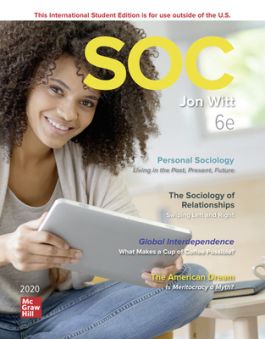SOC 2020 ISE
1260569330
·
9781260569339
Jon Witt’s SOC 2020 takes a non-traditional approach than most introductory sociology textbooks. It sticks very closely to the three sociological theories, but it does so in a way that is more accessible and approachable for students. Witt incorpor…
Read More
After purchasing your eBook, login to the McGraw Hill Bookshelf website and redeem the access code from your order confirmation email.
- Access your eBook online or offline
- Easily highlight and take notes
- Fully searchable content
- Syncs across platforms
NOTE: eBook purchase does not include Connect homework or adaptive SmartBook assignments
Table of Contents
1. The Sociological Imagination
2. Sociological Research
3. Culture
4. Socialization
5. Social Structure and Interaction
6. Deviance
7. Families
8. Education and Religion
9. Government and Economy
10. Social Class
11. Global Inequality
12. Gender and Sexuality
13. Race and Ethnicity
14. Population, Health, and Environment
15. Social Change
Jon Witt’s SOC 2020 takes a non-traditional approach than most introductory sociology textbooks. It sticks very closely to the three sociological theories, but it does so in a way that is more accessible and approachable for students. Witt incorporates relevancy in a very candid way that is familiar to students, yet still formal enough for instructors. The sixth edition of SOC 2020 offers significant changes in each chapter, but the most substantial changes are in Chapter 8 and Chapter 15. Chapter 8, the chapter dedicated to race and ethnicity, has been completely overhauled. The new structure sets the stage for a more sociological informed understanding of race and ethnicity. The updated chapter includes more historical context, a head-on discussion of the limits of biological approaches to race, a consideration of why such biological justifications are put forth, and a more detailed discussion of the consequences of such social constructions. In Chapter 15, instructors will find a more thoughtful discussion of social change. Chapter 15 reinforces the idea that positive social change is possible and how those actions can yield new structures.

